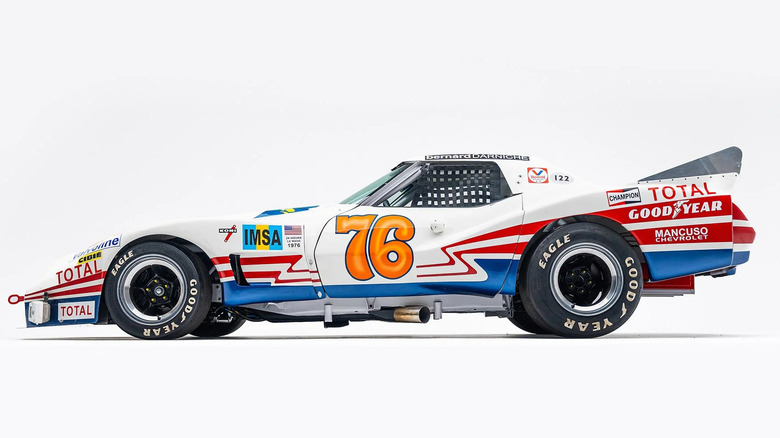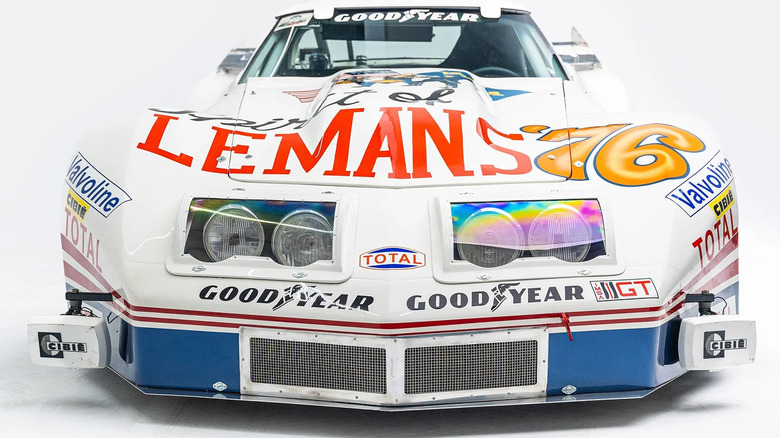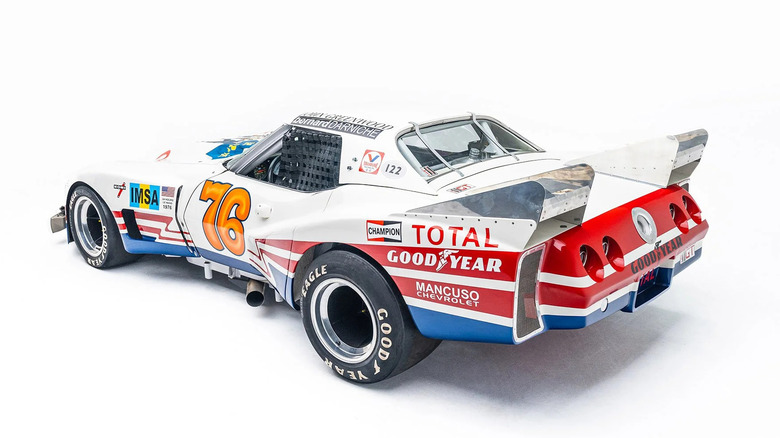The Most Iconic Le Mans Car Isn't A Ford Or Ferrari – It's A 1976 Corvette
Typically, when one pictures vintage Le Mans cars, certain vehicles come to mind. The Porsche 962C, Jaguar D-Type, Ford GT40, Aston Martin DBR1, the supposedly banned Mazda 787B, and so on — all winning machines, all iconic in their own rights. But there's one car which took the phrase "iconic" to the next level, and it's not a European supercar: it's a 1976 Corvette. Enter the "Spirit of Le Mans," a Corvette with possibly one of the wildest body kits ever fitted to a C3, and one of the most American racing liveries ever designed.
1976 saw two separate anniversaries for the United States, with the most obvious being the country's 200th birthday. But it also marked the 10-year anniversary of the first — and so far only — time an American car won the fabled race. That didn't stop one man from giving it his best shot to make the second, however. John Greenwood, the designer of the Spirit of Le Mans, had been modifying Corvettes since the Golden Era of muscle cars. With the Malaise Era in full swing following the 1973 Oil Crisis, the majority of American V8s suffered heavily, with power figures a paltry shadow of what they were on the road. But on the racetrack, no such restrictions existed, making the Spirit of Le Mans quite possibly the fastest Corvette around a circuit in its day.
This Corvette has a fascinating history on its own, being built essentially by a dedicated man with a passion and a dream and fielded in one of the greatest races in motorsports. What, then, is the unique story behind this bizarre vehicle? Let's dive under the hood and explore its anatomy and racing pedigree.
Crafting a racecar by hand
It's a little-known fact that Corvette Racing, started in 1999, holds roots dating back to 1960 with the original C1 Corvette. Since then, the American firm has attempted the 24-hour long race on a number of occasions prior to the team's formation, but none are more distinctive than this car. It boasts a unique fiberglass widebody assembled around a production convertible chassis, originally intended for IMSA racing, hence the reason why it looks the way it does.
To summarize the rulebook, a 1976 IMSA GT car is allowed various widebody extensions while preserving the general silhouette of the production car, meaning the same recognizable roof line, hood, rear decklid, and doors, but with those exaggerated flares to compensate. It competed against similarly wild cars like the Porsche 934/5 and BMW 3.0 CSL, carrying over those restrictions to Le Mans with no major modifications.
Much like the equally bizarre Chaparral 2E, which was banned for its aerodynamic devices, the Spirit of Le Mans featured a number of cutting-edge innovations in its design. The unique body was capable of producing an estimated 1,000 pounds of downforce at full-tilt from the front and rear spoilers, along with vented fenders and a rear diffuser. Vented fenders allow for air to escape from the wheel wells, reducing lift — a trick used on the 1969 Dodge Charger Daytona and 1970 Plymouth Superbird. The rear diffuser acts as a modifier for the air passing underneath the car, helping to keep it firmly planted at high speeds; diffusers remain commonplace today on most racing machines, including all Le Mans racers.
What happened to the Spirit of Le Mans?
The Spirit of Le Mans is a niche car at best today, hardly as well-known as something like the GT40; nevertheless, its extremely distinctive appearance and V8 roar endeared it to fans. Quirky Le Mans cars often do, such as the Panoz-engineered DeltaWing or the Nissan GT-R LM Nismo, as a couple of recent examples. The Spirit of Le Mans left a similarly indelible impact, being unlike virtually anything else on the circuit that day. Moreover, this Corvette wasn't just exotic looking; it was also fast. 222 mph levels of fast, to be specific, thanks to a massive 9.8-liter aluminum Chevrolet V8 producing about 900 horsepower.
In a rare occurrence, John Greenwood was both the designer and the driver, being one of two drivers slated to handle this beast (the other being Frenchman Bernard Darniche). The car itself performed well, qualifying in 9th overall for the race. However, that's where the good news ended — while unquestionably impactful, with some fans even calling it the "Batmobile," the Spirit of Le Mans lasted just 29 laps before suffering a catastrophic fuel leak, costing the Corvette the race.
Its story didn't end with the race itself, however; the car was preserved as a museum piece, displayed at the Petersen Automotive Museum alongside various other iconic racing Corvettes within the "Corvettes in Competition" exhibit. These days, Chevrolet continues to be a dominant presence at the Circuit de la Sarthe, securing a total of 8 class victories since 2001 – with some years better than others, of course.


